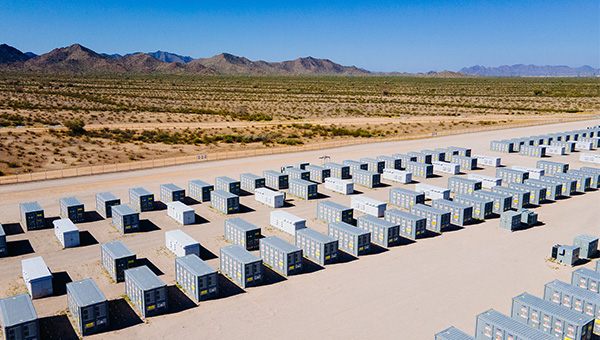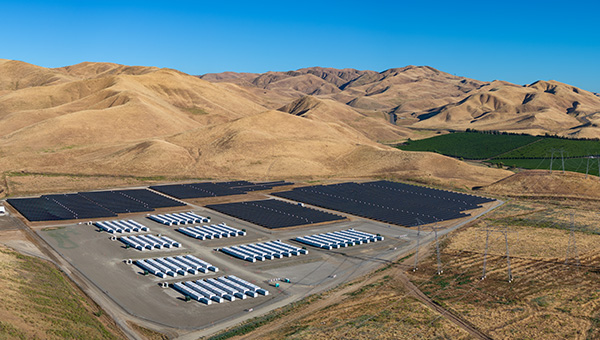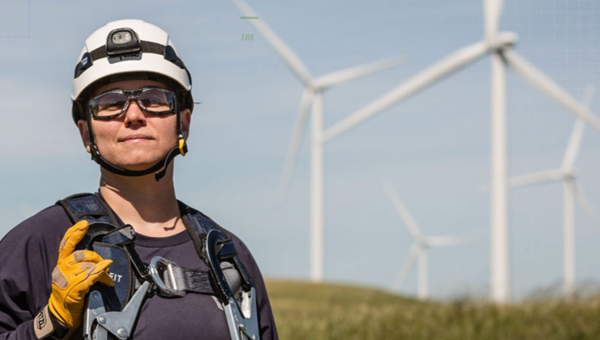Battery Energy Storage
Battery energy storage systems enhance capacity, reliability and savings by optimizing power demand and supply.

Empowering a Smarter, More Resilient Grid
with Battery Energy Storage
Battery energy storage systems are transforming the way we generate, deliver and consume electricity. By storing surplus energy from diverse sources during periods of oversupply and releasing it when demand peaks, these systems help balance the grid—ensuring reliable, flexible and cost-effective power. By balancing supply and demand, battery energy storage strengthens grid reliability and improves economic performance of generation sources like renewables. It also integrates effortlessly with other generation sources, including natural gas-powered generation and nuclear energy.
Benefits of Battery Energy Storage
Battery energy storage provides an opportunity to improve the economics of your power generation, no matter its size. By optimizing how energy is produced and consumed, these systems store power during periods of low demand and deliver it when it’s needed most, helping you maximize value and reliability.
Cost savings
Leverage battery energy storage to capture low-cost power off-peak and dispatch it during high-demand periods. Fixed-payment structures provide long-term price stability and protection from energy market volatility.
Diverse and reliable energy supply
Supplement diverse generation assets with battery energy storage to ensure reliable power delivery. Maintain operational stability and grid resilience—even during intermittent renewable output or demand surges.
Impactful and flexible
Battery energy storage systems scale with growing facilities to maximize the impact of energy generation assets. They balance the grid, reduce disruptions and strengthen the foundation for a more resilient energy future.
New capacity, real impact
Each project contributes “additionality,” adding new energy generation to the grid and helping strengthen overall energy supply.
Frequently Asked Questions
Battery energy storage systems (BESS) store electricity for use during periods of high demand or when energy generation is low. These systems help keep power reliable and the grid stable. BESS can be used for homes, businesses or utility-scale applications. Customers typically incorporate battery storage as part of a broader energy strategy, with systems tailored to meet specific operational needs and energy management goals.
Battery energy storage is transforming how power systems operate—bridging the gap between generation and demand with speed and precision. By storing excess energy when demand is low and releasing it when the grid needs it most, storage improves reliability, resilience and cost control. For utilities, commercial and industrial customers, and communities, this means fewer curtailments, better renewable integration and stronger protection against volatility in energy markets. With battery energy storage, you’re not just managing energy—you’re building a smarter, more stable grid.
For utilities, battery energy storage systems are a flexible, reliable way to manage supply and demand. Stored energy can be deployed during peak periods or outages to maintain consistent service, support grid stability and meet regulatory standards, all while easing the strain of capacity expansion.
Battery energy storage systems are designed with multiple layers of safety features and undergo rigorous testing. Advanced monitoring and control systems help prevent overcharging, overheating and other potential risks. When properly installed and maintained, these systems provide a safe, reliable and secure energy solution.
NextEra Energy Resources designs storage solutions that can perform multiple functions simultaneously, including energy shifting, frequency regulation, peak shaving, voltage support and backup power. Our systems can operate as stand-alone assets or can be paired with energy generation sources to improve dispatchability and reliability. Each project is engineered to meet specific operational goals and maximize performance and economic value throughout its lifecycle.
With more than a decade of experience developing battery energy storage projects, NextEra Energy Resources is a leader in energy storage innovation, scale and execution. We manage every phase of development—from site selection and engineering to construction and long-term operations—with a proven track record of on-time, on-budget delivery.

Boosting Capacity and Reliability for Power Utilities
Read actionable insights on how advanced battery storage solutions can help your utility boost grid reliability, optimize energy economics and seamlessly integrate renewables.

